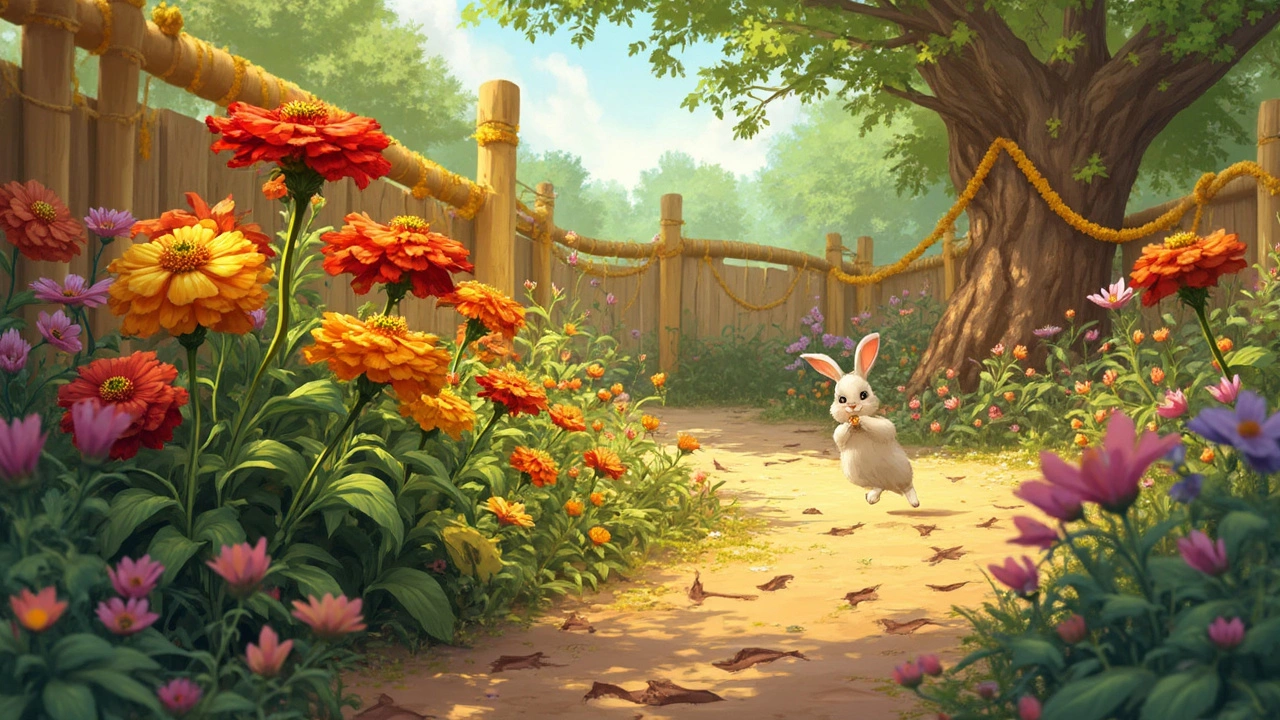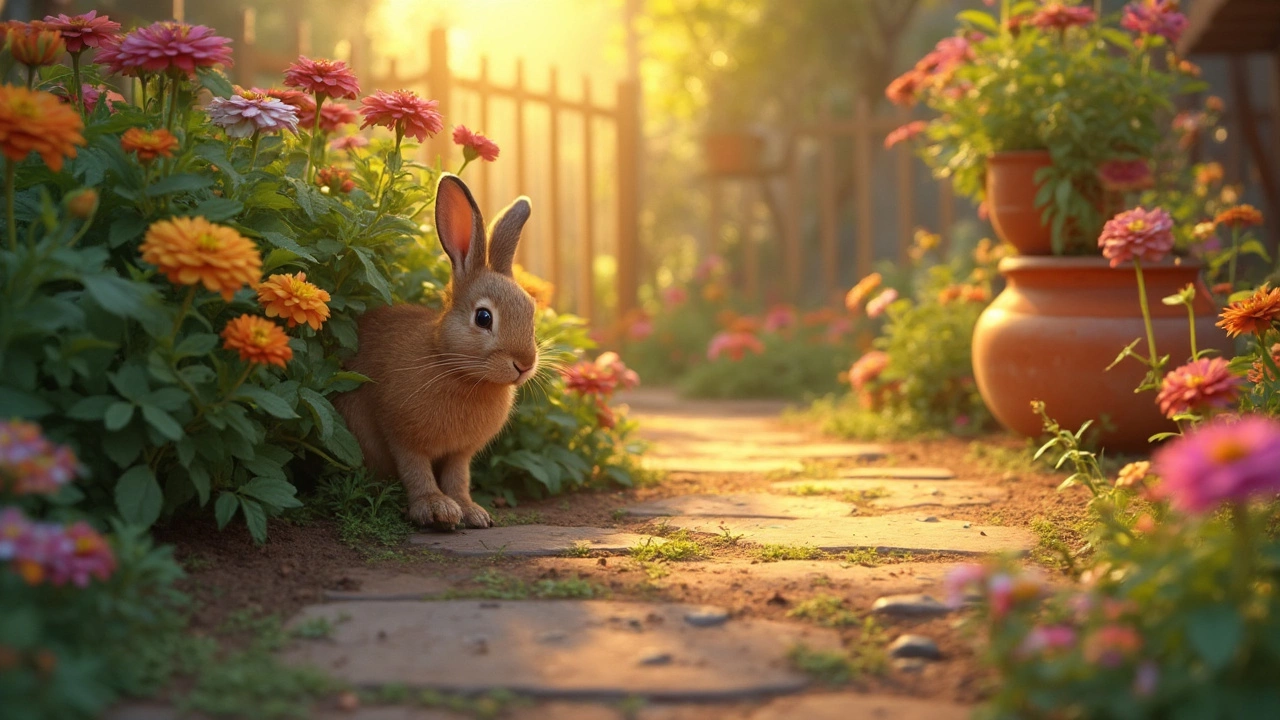Rabbits and beautiful zinnias—a combo that keeps kitchen gardeners guessing. If you’ve planted those bright, cheery flowers only to wake up and find chewed stems or missing blooms, you’re not alone. Rabbits do go after a lot of garden plants at times, and zinnias end up on the menu more often than some realize.
Not every garden turns into a rabbit buffet, though. A lot comes down to what else is growing, how easy it is for rabbits to sneak in, and how desperate they are for food. In a bad drought or when wild greens get scarce, even the most unlikely plants can get gobbled up. So, knowing what puts zinnias at risk is a serious help.
- Do Rabbits Really Eat Zinnias?
- Why Rabbits Target Some Yards
- Spotting Rabbit Damage on Zinnias
- Simple Tricks to Stop Rabbit Munching
Do Rabbits Really Eat Zinnias?
If you’ve heard someone say that rabbits don’t like zinnias, don’t get too comfortable. While zinnias aren’t their top pick, rabbits will eat them, especially if their usual supply of clover or grass dries up. Young zinnia sprouts are a bigger target than mature, tougher plants. The flavors and scent of zinnias put rabbits off a bit, but not enough to keep a stubborn bunny away.
The most important thing to know: rabbits tend to eat whatever is easiest. If your flower bed is the salad bar they notice first, zinnias might become an appetizer. According to a 2019 university extension report, a hungry rabbit can clear several seedlings in a single night. They’re quick, quiet, and rarely leave a mess behind.
Check out this table comparing zinnia damage with other flowers popular with rabbits:
| Plant | Rabbit Preference | Common Damage |
|---|---|---|
| Zinnia | Medium | Nibbled leaves, chewed stems |
| Marigold | Low | Rarely touched |
| Petunia | High | Flowers and foliage eaten |
| Hosta | High | Leaves stripped down |
Their favorite targets in the yard shift season by season, but if food gets scarce, even your prickly or bitter flowers can go missing. Zinnias might dodge the worst of it, but only if rabbits have better choices nearby.
If you’re planting seeds for the kitchen garden, don’t expect rabbits to respect boundaries—they go for young, tender shoots most, but won’t always skip the mature stuff either.
Why Rabbits Target Some Yards
If you notice way more rabbit action in your yard than your neighbor's, it's not just bad luck. Rabbits focus on spots where they feel safe and have plenty to eat—especially if the menu includes garden favorites like zinnias or other lush plants.
Brush piles, open sheds, thick grass, or even a stack of old crates can give rabbits the shelter they need. They aren’t picky about what works as cover, as long as it hides them from predators. A yard with lots of hiding spots is way more tempting to a rabbit than one that’s open and clean-cut.
What you plant matters, too. Fresh seedlings, clover patches, leafy greens, and young blooms light up a rabbit’s radar. Zinnias may not be their first snack choice in spring. But in late summer, when their usual food is running out or when there’s a dry spell, they’ll try almost anything—including zinnias.
Here’s a look at why some places get targeted more than others:
- Rabbits prefer yards with thick, low-to-the-ground greenery for easy hideouts.
- Compost heaps, brush, and old boards provide perfect rabbit cover.
- Lawns with lots of clover or dandelions don’t just attract pollinators—they’re a buffet for rabbits.
- Unfenced gardens close to fields or woods are easier for rabbits to invade.
Check out this snapshot of what attracts (or doesn’t attract) rabbits:
| Attracts Rabbits | Doesn’t Attract Rabbits |
|---|---|
| Thick ground cover, cluttered corners | Open spaces, trimmed lawns |
| Piles of brush or debris | Garden fencing (over 2 feet tall) |
| Young, tender plants (including zinnias in summer) | Strong-smelling herbs, mature shrubs |
One last thing: rabbits breed fast—a single pair can have dozens of babies in a season. If your place gives them food and cover, you’re basically putting up a “Welcome” sign for every bunny in the neighborhood.

Spotting Rabbit Damage on Zinnias
It can be a challenge to know if rabbits are the actual culprits chewing up your zinnias. But a few things make their work stand out. Rabbits don’t nibble at plants the same way insects or deer do. Instead, they leave pretty clean, angled bites—almost like the stem got cut off with a small pair of scissors.
The most obvious sign: missing leaves or flower heads, snipped off close to the ground. New growth, young leaves, and fresh blooms almost always go first since they’re the easiest and tastiest for rabbits. If you notice only the bottom part of your zinnias looking rough while the rest stays untouched, you've likely got rabbit visitors.
Here’s what to look for if you suspect rabbits:
- Plants clipped off at a sharp angle (about 45 degrees)
- Young shoots and buds missing or trimmed low
- Little round poops (they look like brown peas) scattered nearby
- Tracks in soft soil—rabbit prints show four toes in the front and longer, wider hind feet
For a quick look at how rabbits compare to other common garden pests, check this:
| Clue | Rabbits | Deer | Insects |
|---|---|---|---|
| Bite marks | Clean, angled cuts | Jagged, torn bites | Irregular holes |
| Height of damage | Low to ground | Can reach higher stems | All over, often inside out |
| Droppings | Small, round pellets | Larger, clumped pellets | Rarely visible |
If you spot these tell-tale signs around your zinnias, you can bet rabbits are snacking in your garden. Early spotting is key, so you can jump in with solutions before all your flowers are history.
Simple Tricks to Stop Rabbit Munching
Not all hope is lost if rabbits have a taste for your zinnias. Kitchen gardeners can actually outsmart those fluffy marauders with a few tried-and-true methods.
- Fencing: The single most effective method is a small wire fence. Hardware cloth with half-inch holes, buried 6 inches deep and standing at least 18 inches tall, turns most rabbits away fast. Pro tip: Check for gaps regularly because young bunnies can squeeze through spots you’d never expect.
- Natural repellents: Sprinkle blood meal or crushed red pepper around your zinnias. Rabbits have sensitive noses, and these smells tend to drive them off. Commercial rabbit repellents aren’t perfect—don’t count on them during rainy spells, as they wash away pretty quickly.
- Distract with decoys: Plant clover, lettuce, or dandelion a distance away from your zinnias. When rabbits have easier targets, they’re likely to skip your prized patch.
- Motion-activated gadgets: Small garden sprinklers or even motion-triggered lights give most rabbits a fright. Just remember, the braver ones get used to these gadgets over time, so keep moving them around.
- Clean up brush and hiding spots: Rabbits love to snack where they feel safe, so clearing out thick weeds and piles of sticks from around your garden really helps lower visits in the first place.
Some folks are surprised at how stubborn rabbits can be. According to a 2024 Cornell University survey, over 60% of home gardeners reported that simple barriers worked better than sprays or gadgets to guard those bright flowers.
| Rabbit Control Method | Effectiveness (%) |
|---|---|
| Physical Fencing | 85 |
| Natural Repellents | 55 |
| Decoy Crops | 45 |
| Motion Sprinklers | 35 |
If you want to avoid munching disasters, put your effort where it counts—wire fences or a good smell barrier will save you hours of frustration. Don’t forget to check your garden often, especially in spring when new rabbits start exploring.
Stick with these steps, and your zinnias will have a fighting chance against hungry bunnies.

